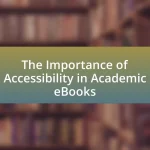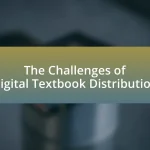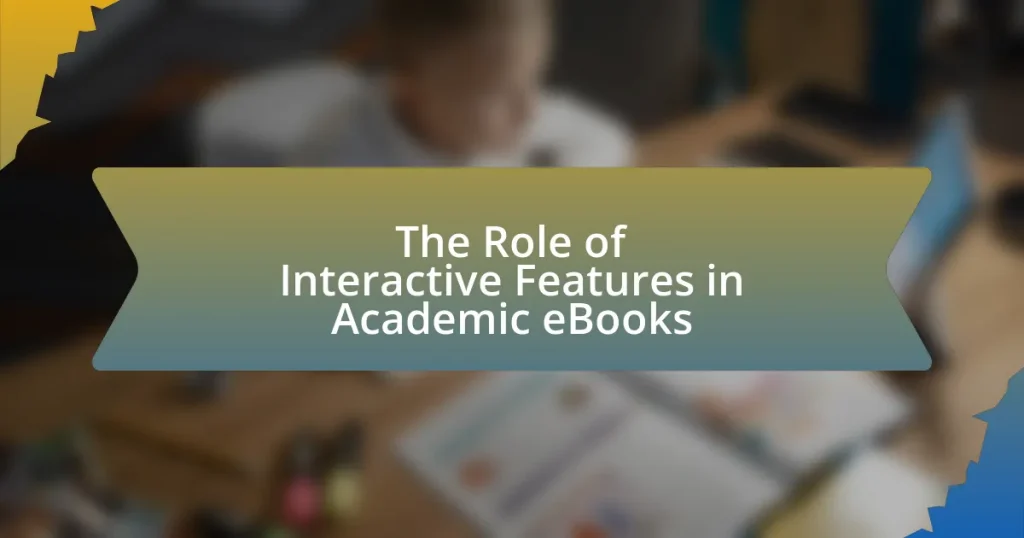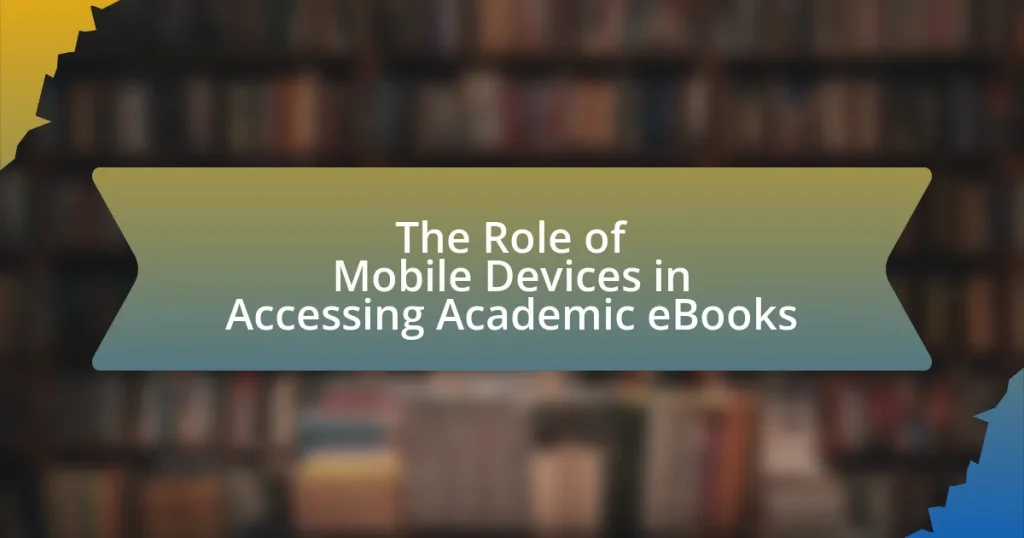Subscription services for academic textbooks are platforms that provide students and educators with access to a diverse range of academic texts for a recurring fee, offering a cost-effective alternative to traditional textbook purchasing. These services allow users to read, download, or borrow textbooks digitally, often resulting in significant savings and access to the latest editions. The article explores the differences between subscription services and traditional purchasing, key features, pricing models, and the growing popularity of these services in academia due to their affordability and accessibility. Additionally, it addresses the impact on the publishing industry, challenges faced by subscription services, and best practices for students to maximize their benefits.
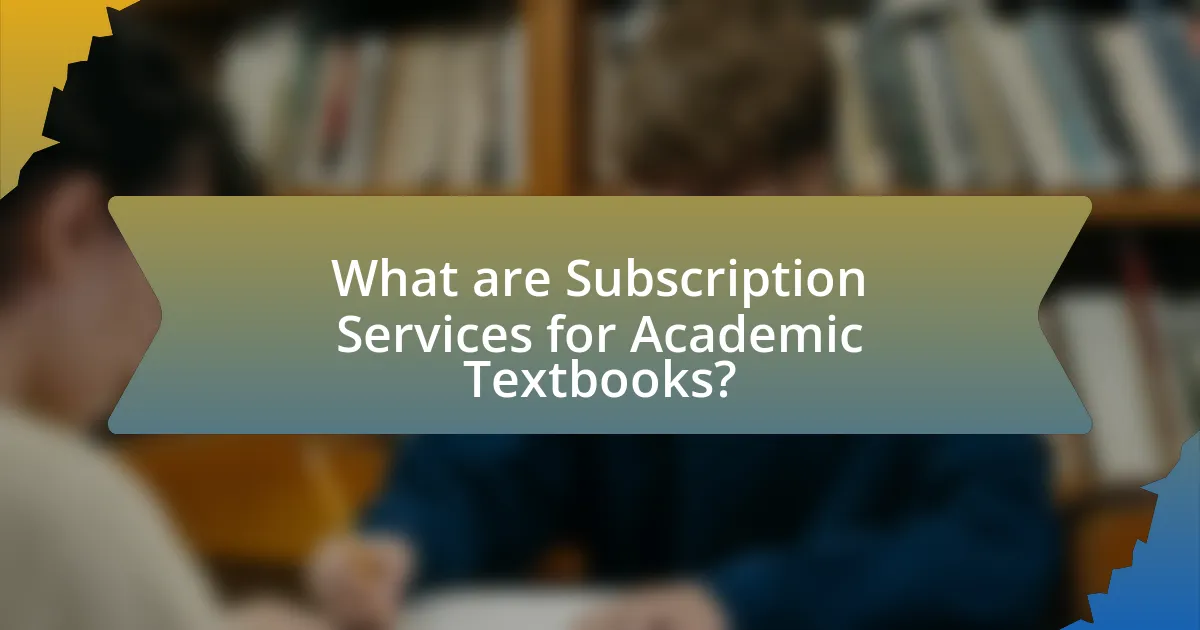
What are Subscription Services for Academic Textbooks?
Subscription services for academic textbooks are platforms that provide students and educators access to a wide range of academic texts for a recurring fee. These services allow users to read, download, or borrow textbooks digitally, often offering a more affordable alternative to purchasing individual books. For instance, platforms like Chegg and VitalSource have gained popularity by providing extensive libraries of academic materials, enabling users to access multiple titles without the high costs associated with traditional textbook purchases. This model not only reduces financial barriers for students but also promotes the use of up-to-date resources, as many subscription services frequently update their offerings to include the latest editions and new publications.
How do subscription services differ from traditional textbook purchasing?
Subscription services differ from traditional textbook purchasing primarily in their payment model and access flexibility. Traditional textbook purchasing requires a one-time payment for ownership of a physical or digital book, often resulting in high upfront costs, while subscription services operate on a recurring fee basis, allowing users to access a wide range of textbooks without the burden of high initial expenses. This model enables students to access multiple resources for a lower overall cost, as they can choose to subscribe for a semester or a year, depending on their needs. Additionally, subscription services often provide the latest editions and updates, ensuring that users have access to current information, unlike traditional purchases where users may be stuck with outdated materials.
What are the key features of subscription services for academic textbooks?
Key features of subscription services for academic textbooks include access to a wide range of titles, affordability through lower upfront costs, and flexibility in usage. These services often provide unlimited or tiered access to digital textbooks, allowing students to select materials based on their specific courses or needs. Additionally, many subscription models offer features such as offline access, interactive content, and regular updates to ensure that users have the latest editions. The affordability aspect is supported by the fact that traditional textbook purchases can exceed hundreds of dollars, while subscriptions typically range from $10 to $50 per month, making them more accessible for students.
How do pricing models vary among different subscription services?
Pricing models among different subscription services for academic textbooks vary primarily in structure, duration, and access levels. For instance, some services offer tiered pricing based on the number of titles accessed, while others may provide a flat fee for unlimited access to their entire catalog. Additionally, subscription durations can range from monthly to annual plans, influencing overall costs. A study by the National Association of College Stores indicates that subscription services can reduce textbook costs by up to 50% compared to traditional purchasing methods, highlighting the financial benefits of these varied pricing models.
Why are subscription services gaining popularity in academia?
Subscription services are gaining popularity in academia primarily due to their cost-effectiveness and accessibility. These services allow students and institutions to access a wide range of academic resources without the high upfront costs associated with purchasing individual textbooks. For instance, a study by the National Association of College Stores found that students can save up to 50% on educational materials through subscription models compared to traditional purchasing methods. Additionally, subscription services provide instant access to updated content, which is crucial in fast-evolving fields, ensuring that users have the latest information at their fingertips. This combination of affordability and immediacy is driving the adoption of subscription services in academic settings.
What factors contribute to the shift towards subscription models?
The shift towards subscription models in academic textbooks is primarily driven by cost-effectiveness, accessibility, and evolving consumer preferences. Cost-effectiveness allows students to access a wide range of materials for a lower upfront investment compared to purchasing individual textbooks. Accessibility is enhanced as subscription services provide instant access to digital content from anywhere, accommodating diverse learning environments. Additionally, evolving consumer preferences reflect a growing demand for flexibility and convenience, as students increasingly favor models that allow them to pay for only what they use. According to a study by the National Association of College Stores, 70% of students prefer digital formats, which further supports the transition to subscription-based services.
How do student needs influence the rise of these services?
Student needs significantly influence the rise of subscription services for academic textbooks by driving demand for affordable and accessible educational resources. As tuition costs and living expenses increase, students seek cost-effective alternatives to traditional textbook purchasing, leading to a preference for subscription models that offer a wide range of materials at a lower overall cost. According to a 2021 survey by the National Association of College Stores, 70% of students reported that high textbook prices impacted their decision to purchase required materials, highlighting the financial burden textbooks impose. This financial pressure has prompted educational institutions and publishers to adapt by developing subscription services that cater to these needs, ensuring students can access necessary resources without incurring excessive costs.
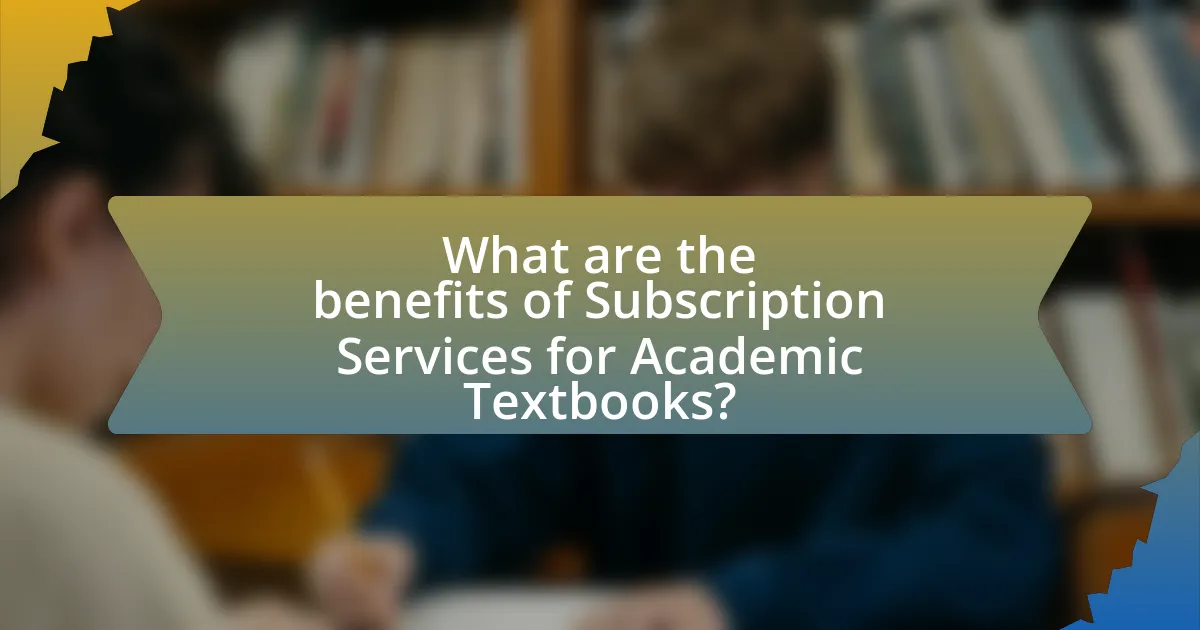
What are the benefits of Subscription Services for Academic Textbooks?
Subscription services for academic textbooks provide cost savings, access to a wide range of materials, and flexibility for students. These services typically offer lower upfront costs compared to purchasing individual textbooks, allowing students to save money, especially when textbooks can exceed $100 each. Additionally, subscription models grant access to a vast library of academic resources, enabling students to explore various subjects without the need to buy multiple books. This model also allows for flexibility, as students can access materials on-demand and choose subscriptions that fit their academic needs and schedules. According to a study by the National Association of College Stores, students using subscription services reported a 30% reduction in textbook costs, highlighting the financial benefits of this approach.
How do subscription services enhance accessibility for students?
Subscription services enhance accessibility for students by providing affordable and flexible access to a wide range of academic resources. These services often offer unlimited access to textbooks, research articles, and educational materials for a fixed monthly fee, significantly reducing the financial burden associated with purchasing individual textbooks. For instance, a study by the National Association of College Stores found that students can save up to 50% on educational materials through subscription models compared to traditional purchasing methods. This affordability allows students from diverse economic backgrounds to access essential learning materials, thereby promoting equity in education.
What role does affordability play in student adoption of these services?
Affordability significantly influences student adoption of subscription services for academic textbooks. When subscription costs are lower than traditional textbook purchases, students are more likely to opt for these services, as they provide access to a wider range of materials without the burden of high upfront costs. For instance, a study by the National Association of College Stores found that 70% of students reported that the high price of textbooks affected their decision to purchase them, leading many to seek more affordable alternatives like subscriptions. This trend indicates that as subscription services offer competitive pricing, they become increasingly attractive to students, facilitating greater adoption rates.
How do subscription services support diverse learning styles?
Subscription services support diverse learning styles by offering a variety of content formats, including text, video, and interactive materials, which cater to different preferences. For instance, visual learners benefit from video lectures and infographics, while auditory learners can engage with podcasts and audiobooks. Additionally, these services often provide customizable learning paths, allowing users to select resources that align with their individual learning preferences. Research indicates that personalized learning experiences can enhance retention and understanding, as evidenced by a study published in the Journal of Educational Psychology, which found that tailored educational approaches significantly improve student outcomes.
What challenges do subscription services face in the academic market?
Subscription services in the academic market face several challenges, including pricing pressures, competition from free resources, and the need for institutional buy-in. Pricing pressures arise as institutions and students seek affordable options, often leading to resistance against subscription models that may seem costly compared to traditional purchasing. Competition from free resources, such as open educational resources (OER), further complicates the landscape, as these alternatives can undermine the perceived value of subscription services. Additionally, gaining institutional buy-in is crucial, as many universities and colleges must approve subscriptions, and their decision-making processes can be slow and complex. These challenges highlight the need for subscription services to demonstrate clear value and adaptability in a rapidly evolving academic environment.
How do publishers respond to the rise of subscription services?
Publishers respond to the rise of subscription services by adapting their business models to include subscription offerings and enhancing digital content accessibility. Many academic publishers, such as Elsevier and Wiley, have launched subscription platforms that provide institutions with access to a wide range of academic materials, thereby increasing their market reach. This shift is supported by the growing demand for flexible and cost-effective access to educational resources, as evidenced by a report from the Association of American Publishers, which indicated a significant increase in digital content consumption among students and institutions. Additionally, publishers are investing in technology to improve user experience and analytics, ensuring that their subscription services meet the evolving needs of educators and learners.
What are the potential drawbacks for students using these services?
The potential drawbacks for students using subscription services for academic textbooks include limited access to materials, dependency on internet connectivity, and potential financial costs over time. Limited access arises because not all textbooks may be available on these platforms, restricting students’ ability to obtain necessary resources. Dependency on internet connectivity can hinder students in areas with poor access, making it difficult to utilize the service effectively. Additionally, while subscription fees may seem lower than purchasing textbooks outright, cumulative costs can exceed traditional textbook expenses if students subscribe for multiple semesters or courses.
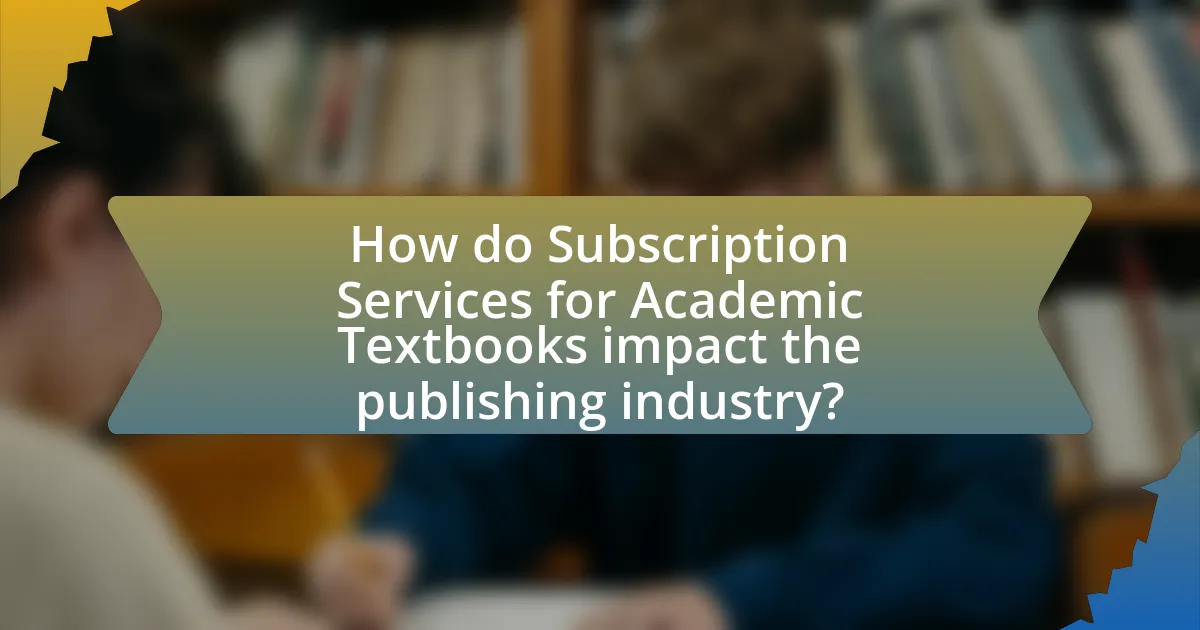
How do Subscription Services for Academic Textbooks impact the publishing industry?
Subscription services for academic textbooks significantly disrupt the traditional publishing industry by altering revenue models and access to educational materials. These services provide students with affordable access to a wide range of textbooks, which reduces the demand for individual textbook purchases. As a result, publishers face declining sales of physical textbooks, leading to a shift in focus towards digital content and subscription-based models. According to a report by the Association of American Publishers, digital content sales have increased by over 20% in recent years, reflecting this trend. Additionally, subscription services encourage publishers to innovate in content delivery and licensing, as they must compete with the convenience and cost-effectiveness of these platforms.
What changes are occurring in textbook publishing due to subscription models?
Textbook publishing is experiencing significant changes due to subscription models, primarily shifting from traditional ownership to access-based consumption. This transition allows students and institutions to access a wide range of textbooks for a flat fee, reducing the overall cost of educational materials. According to a study by the National Association of College Stores, subscription services can lower textbook expenses by up to 50%, making education more affordable. Additionally, subscription models facilitate continuous updates to content, ensuring that students have access to the latest information without needing to purchase new editions. This model also encourages publishers to focus on digital formats, enhancing accessibility and interactivity in learning materials.
How are publishers adapting their strategies in response to subscription services?
Publishers are adapting their strategies by shifting towards flexible pricing models and enhancing digital content offerings in response to subscription services. This includes implementing tiered subscription plans that cater to different user needs, allowing for broader access to academic materials. For instance, major publishers like Wiley and Springer have introduced subscription models that provide institutional access to a wide range of textbooks and journals, which has been shown to increase usage rates among students and faculty. Additionally, publishers are investing in user-friendly platforms that facilitate seamless access to digital resources, thereby improving the overall user experience and engagement with their content.
What implications does this have for the future of academic publishing?
The rise of subscription services for academic textbooks will significantly alter the future of academic publishing by shifting the financial model from ownership to access. This transition may lead to reduced costs for students and institutions, as subscription models often provide a wider range of materials at a lower price compared to traditional purchasing. Additionally, the increased accessibility of resources can enhance collaboration and knowledge sharing among researchers and educators. According to a 2021 study by the Association of American Publishers, subscription services have the potential to increase the dissemination of academic work, as they allow for more flexible and immediate access to content. This shift may also challenge traditional publishers to adapt their business strategies, potentially leading to more open-access initiatives and innovative publishing formats.
What are the best practices for students using subscription services for academic textbooks?
Students using subscription services for academic textbooks should prioritize selecting the right service that offers a comprehensive range of titles relevant to their courses. This ensures access to necessary materials without incurring high costs. Additionally, students should take advantage of free trial periods to evaluate the service’s usability and content availability before committing financially.
Furthermore, students should regularly check for updates and new releases within the subscription service, as many platforms frequently add new titles that may be beneficial for their studies. Utilizing features such as bookmarks and notes can enhance the learning experience by allowing students to organize and reference important information easily.
Lastly, students should be mindful of the subscription terms, including cancellation policies and renewal fees, to avoid unexpected charges. By following these best practices, students can maximize the benefits of subscription services while minimizing costs and enhancing their academic performance.
How can students maximize their benefits from these services?
Students can maximize their benefits from subscription services for academic textbooks by actively engaging with the platform’s features and utilizing available resources. By regularly accessing the service, students can take advantage of a wide range of textbooks and materials that are often updated, ensuring they have the most current information. Additionally, utilizing features such as search functions, bookmarks, and note-taking tools can enhance their study efficiency. Research indicates that students who engage with digital resources more frequently tend to achieve higher academic performance, as they can tailor their learning experience to their specific needs and preferences.
What tips should students consider when selecting a subscription service?
Students should consider the cost, content availability, and user experience when selecting a subscription service for academic textbooks. Cost is crucial; students should evaluate whether the subscription fits their budget and offers good value compared to purchasing textbooks outright. Content availability is also important; students need to ensure that the service provides access to the specific textbooks and resources required for their courses. User experience, including the platform’s ease of navigation and accessibility features, can significantly impact how effectively students can utilize the service. Research indicates that students who choose subscription services with a wide range of relevant materials and user-friendly interfaces report higher satisfaction and academic performance.







